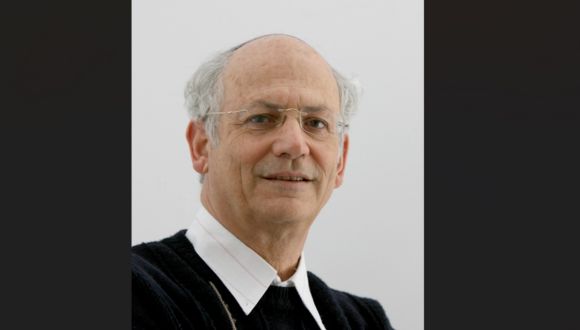Gaia Spacecraft Reveals Massive Black Hole in Milky Way


Research
Gaia Spacecraft Reveals Massive Black Hole in Milky Way

An international team of researchers, with the participation of researchers from Tel Aviv University (TAU) led by Prof. Tsevi Mazeh, discovered a star which orbits a black hole 33 times heavier than the sun’s mass, and lies 1500 light-years away from Earth. The black hole, discovered using data from the European Gaia spacecraft, is more than three times heavier than the other known black holes in our galaxy.
The Gaia spacecraft was launched by the European Space Agency in 2013 and has since then been regularly measuring the position and brightness of over a billion stars in our galaxy – the Milky Way galaxy – with unprecedented precision, equivalent to accurately determining the position of a single grain of sand on the moon to the millimeter.
An organization of hundreds of scientists across Europe processes the data coming in from the spacecraft and makes it accessible to the entire scientific community. The research group was led by Prof. (emeritus) Tsevi Mazeh, from TAU’s Raymond and Beverly Sackler School of Physics and Astronomy, recently awarded the Israel Prize in Physics for the year 2024. Prof. Mazeh participates in the study of binary star systems discovered using spacecraft data. The research was published in the prestigious journal Astronomy & Astrophysics.

Credit: ESA/Gaia/DPAC
Cosmic Odyssey: Exploring the Depths of the Universe
The large sample of binary stars should also include systems which include a black hole - one of the rarest celestial objects in the universe. The existence of a black hole is one of the most amazing phenomena in the universe, the existence of which was predicted by Einstein’s theory of general relativity back in 1939.
According to the accepted theory, when the fuel for the nuclear combustion process that takes place in the core of a star runs out, it collapses in on itself, towards its center. If the star is massive enough, all the remaining matter collapses into a single point of infinite density. It is possible, therefore, to see the black hole as the “corpse” of a star that has ended its life cycle and collapsed in on itself. Astrophysicists are still trying to understand the extreme conditions that lead to the collapse of matter into the central point, and therefore every discovery of a black hole is accompanied by enormous excitement among astronomers.
Into the Abyss of the Black Hole
It is very difficult to discover black holes since light cannot overcome the strong gravitational force in its vicinity. When a black hole is in a binary system with a normal star, the motion of the visible star is used to measure the mass of its invisible partner and thus prove that it is indeed a black hole. Indeed, in a matter of just a few years, the Gaia spacecraft has already discovered two black holes.
With the expectation that the data that continues to be collected by the spacecraft will lead to the discovery of more black holes, Prof. Mazeh together with Prof. Laurent Eyer from the University of Geneva established a small team to find black holes using the spacecraft’s data, including scientists from France, Germany, Spain, Belgium, Poland and Switzerland. While examining the new data, the team came across a binary system containing a special black hole, the likes of which has never been found before, with a mass of 33 solar masses, around 1,500 light years away from us.
The new black hole is more than three times heavier than any other known black hole in the Milky Way galaxy. The binary system, named Gaia BH3, contains an ordinary star that seems to have formed more than ten billion years ago when our galaxy was still very young. The star orbits the black hole in an 11-year cycle.

Prof. Tsevi Mazeh - 2024 Israel Prize Winner in Physics
At the suggestion of Prof. Mazeh, it was decided to publish the sensational disclosure right now and not wait until the orderly publication of all the systems that were discovered. The entire spacecraft team, including researchers from TAU - Prof. Shay Zucker, head of the Porter School of Environment and Earth Sciences, Dr. Simchon Faigler, Dr. Sahar Shahaf (now at the Weizmann Institute), Dr. Dolev Bashi (now at the University of Cambridge), Avraham Binnenfeld (research student) and Oded Orenstein (second-year undergraduate student) - are listed as contributors to the scientific article published today which reports on the discovery.
Prof. Tsevi Mazeh: “This is an exciting discovery of the heaviest black hole in a binary system known today in the galaxy. About thirty years passed from the first hypothesis of the existence of a black hole until the discovery of the first black hole, and more than fifty years passed before we were able to discover Gaia BH3 - the binary system with the longest cycle known today. It is amazing how humankind manages to navigate the vast expanses of the universe and discover such mysterious objects. I am convinced that the discovery will lead to a new mode of thinking regarding the presence and prevalence of the black holes that cruise through the expanses of our galaxy.”

Research
A Recent TAU Study Exposes the Connection Between Heart Disease and Cancer

Researchers at Tel Aviv University and the Leviev Cardiothoracic and Vascular Center at the Sheba Medical Center have found a mechanism that is responsible for increasing the risk of developing cancer among patients with heart disease: those small extracellular bubbles, or vesicles (sEVs), that are secreted from the sick heart to heal itself are released into the bloodstream – and promote the growth of cancer cells throughout the body. The researchers estimate that the important discovery may improve the protocols for treating heart disease so that clinicians also consider the increased risk of cancer. The study was funded by the Israel Cancer Association and the Israel Science Foundation.
The research was conducted under the leadership of Prof. Jonathan Leor from the Neufeld Cardiac Research Institute, Faculty of Medical & Health Sciences at Tel Aviv University and the Taman Institute at Sheba’s Leviev Center and his student Tal Caller, a medical and research student at Tel Aviv University's School of Medicine. The research was published in the important medical journal Circulation.
Caller explains: “In 2013, the Israeli cardiologist Tal Hasin showed for the first time that there is a connection between heart failure and cancer. Patients with heart disease are at a higher risk of developing cancer, and since heart disease is already a leading cause of death–first place in the US and second place in Israel – that means that many people are at risk. Our research revealed that the diseased heart secretes cancer-promoting factors, which we identified as small extracellular vesicles (sEVs). These are tiny particles wrapped in a simple membrane, which all cells secrete, However, due to heart damage, these vesicles are released in greater quantities and contain factors related to inflammation, healing, growth, creation of new blood vessels, and changes in the immune system. These vesicles move through the circulatory system and eventually reach the tumor or the pre-cancerous tissue”.
Caller adds, “Following an injury in the heart muscle and deterioration to heart failure, sEVs containing growth factors and small nucleic acid molecules that promote cell division are released. These sEVs contribute to the healing of the injured cardiac tissue. However, released from the injured heart, those vesicles move within the body’s circulatory system, eventually targeting cancerous growths”.
Prof. Jonathan Leor: “Many theories have been proposed to explain the increased risk of cancer in heart patients. They started with shared risk factors such as smoking, diabetes, and obesity and ended with a single protein or molecule. We showed for the first time that the diseased heart secretes sEVs that contain thousands of different growth factors. These bubbles directly promote the growth of certain tumors and also modulate the immune system, making the body more vulnerable to tumor growth”.
To test their hypothesis, the researchers at TAU inhibited the formation of sEVs in animal models with heart disease and found that the risk of cancer decreases along with the inhibition of vesicle production. However, this is not a viable therapeutic option since inhibiting the production of the vesicles causes severe undesired side effects.
Prof. Leor: “When you systemically inhibit the formation of sEVs, you get less cancer – but you cause collateral damage along the way. That is why we tried a different strategy: treat the patient’s heart to reduce the damage to the cardiac tissue so that it secretes fewer sEVs. We used spironolactone, which is a well-known, old, and effective drug used to treat heart failure. We treated the animals with spironolactone at a very early stage of the disease and found that the heart secreted 30% fewer sEVs– and the cancerous tumors grew more slowly. Our experiment shows that it is possible to intervene in heart disease in a way that reduces the risk of cancer among heart patients”.
As for the clinical implications of the study, Caller is careful in his words: “It may be necessary to adjust the existing treatments for the heart so that they also consider the risk of cancer. In addition, it is possible to find biomarkers among heart patients that will indicate an increased risk of cancer since not all patients are at an increased risk. This is basic research, and much work is still required to unravel the connection between the two”.
Moshe Bar-Haim, CEO of the Israel Cancer Association, adds: “Thanks to public donations and designated funds, the research committee of the Israel Cancer Association examines and selects dozens of studies every year and funds researchers and doctors from research and treatment centers across Israel. From these studies, new methods were developed for the diagnosis, treatment, and rehabilitation of cancer patients. Research has no territorial boundaries, so every achievement in research here in Israel is an achievement for the entire world. We hope that the new research – that reveals that because of heart diseases, extracellular bubbles are secreted and increase the risk of cancer – will allow for immediate application in Israel and around the world for the benefit of accurate treatment for patients”.

Research
How Does Global Warming Impact Fish Abundance?

An extensive international study led by researchers from Tel Aviv University found a decline in the abundance of marine fish species that rapidly move toward the poles to escape rising sea temperatures. The researchers explain that many animal species are currently moving toward cooler regions as a result of global warming, but the velocity of such range shifts varies immensely for different species. Examining thousands of populations from almost 150 fish species, the researchers show that contrary to the prevailing view, rapid range shifts coincide with widescale population declines. According to the study, on average, a poleward shift of 17km per year may result in a decline of 50% in the abundance of populations.
The international study was led by Ph.D. student Shahar Chaikin and Prof. Jonathan Belmaker from the School of Zoology in the Wise Faculty of Life Sciences and the Steinhardt Museum of Natural History at Tel Aviv University. The paper was published in the leading scientific journal Nature Ecology & Evolution.
For the first time, the new study correlated two global databases: (1) a database that tracks fish population size over time, and (2) a database that compiles range shift velocities among marine fishes. Altogether, 2,572 fish populations belonging to 146 species were studied, mostly from the Atlantic and Pacific Oceans in the Northern Hemisphere.

Left to right - Prof. Jonathan Belmaker and Shahar Chaikin
Prof. Belmaker explains: "We know that climate change causes animal species to move – northward, southward, upwards, or downwards – according to their location relative to cooler regions. In the mountains they climb upwards, in the oceans they dive deeper, in the Southern Hemisphere they move south toward Antarctica, and in the Northern Hemisphere, they move north toward the North Pole. In the present study we wanted to see what happens to species that move from one place to another: do they benefit by increased survivability, or are they in fact harmed by the shift – which was initially caused by greater vulnerability to climate change? We found that the faster fish shift toward the poles, the faster their abundance declines. Apparently, it is difficult for these populations to adapt to their new surroundings".
PhD student Chaikin: "We found that species shifting their geographical range more rapidly towards the poles, are in fact more likely to lose their abundance (e.g. European seabass). Additional findings show differences between populations that are closer to or further from the poles - within the geographical range of a particular species. While it might have been assumed that populations closer to the cooler polar margins of the species range would be less affected by climate change, we found that the opposite is true: fast poleward range shifts of populations from higher latitudes resulted in a more rapid decline in abundance compared to equatorial populations of the same species".
The researchers highlight that the new findings can and should guide environmental decisionmakers, by enabling a reevaluation of the conservation status of various species and populations. The study's results suggest that populations exhibiting rapid poleward range shifts require close monitoring and careful management. Thus, for example, pressures that threaten their survival can be mitigated through measures like fishing limits.
Prof. Belmaker: "The common belief is that rapid range shifts safeguard a species against local population decline. But in this study, we found that the opposite is true. Apparently, species rapidly shifting their range in search of cooler temperatures do so because they are more vulnerable to climate change, and consequently require special attention. Last year we published another study that focused on local fish species along Israel's coastline, which resulted in similar findings: species that move towards deeper and cooler habitats in the face of rising water temperatures exhibit declining populations. In the next stage of our research, we intend to investigate this causal relationship in additional marine species, other than fish".